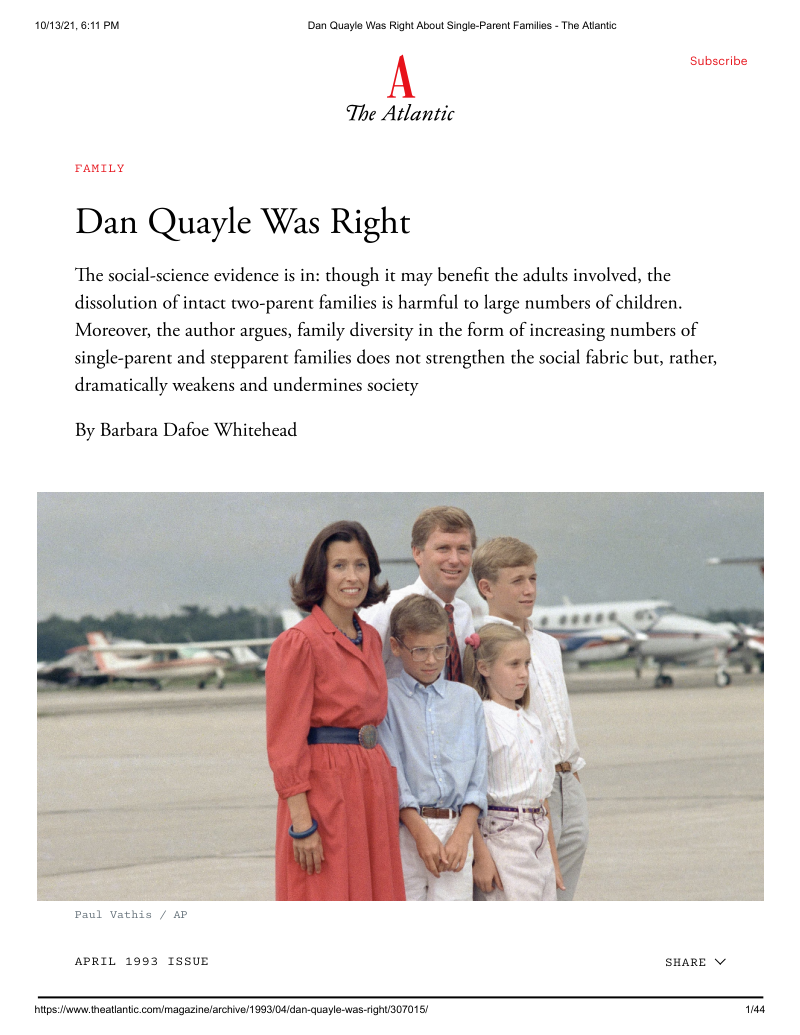Whitehead reports on the social science of family breakdown.
- Type
- Periodical
- Source
- N/A Non-LDS
- Hearsay
- Scribed VerbatimDirectSecondaryJournalism
- Reference
Barbara Dafoe Whitehead, "Dan Quayle Was Right," The Atlantic (April 1993), accessed October 13, 2021
- Scribe/Publisher
- The Atlantic
- People
- N/A
- Audience
- Reading Public
- Transcription
Divorce and out-of-wedlock childbirth are transforming the lives of American children. In the postwar generation more than 80 percent of children grew up in a family with two biological parents who were married to each other. By 1980 only 50 percent could expect to spend their entire childhood in an intact family. If current trends continue, less than half of all children born today will live continuously with their own mother and father throughout child hood. Most American children will spend several years in a single-mother family. Some will eventually live in stepparent families, but because stepfamilies are more likely to break up than intact (by which I mean two-biological-parent) families, an increasing number of children will experience family breakup two or even three times during childhood.
According to a growing body of social-scientific evidence, children in families disrupted by divorce and out-of-wedlock birth do worse than children in intact families on several measures of well-being. Children in single-parent families are six times as likely to be poor. They are also likely to stay poor longer. Twenty-two percent of children in one-parent families will experience poverty during childhood for seven years or more, as compared with only two percent of children in two parent families. A 1988 survey by the National Center for Health Statistics found that children in single-parent families are two to three times as likely as children in two-parent families to have emotional and behavioral problems. They are also more likely to drop out of high school, to get pregnant as teenagers, to abuse drugs, and to be in trouble with the law. Compared with children in intact families, children from disrupted families are at a much higher risk for physical or sexual abuse.
Contrary to popular belief, many children do not "bounce back" after divorce or remarriage. Difficulties that are associated with family breakup often persist into adulthood. Children who grow up in single-parent or stepparent families are less successful as adults, particularly in the two domains of life—love and work—that are most essential to happiness. Needless to say, not all children experience such negative effects. However, research shows that many children from disrupted families have a harder time achieving intimacy in a relationship, forming a stable marriage, or even holding a steady job.
. . .
Over the past two and a half decades Americans have been conducting what is tantamount to a vast natural experiment in family life. Many would argue that this experiment was necessary, worthwhile, and long overdue. The results of the experiment are coming in, and they are clear. Adults have benefited from the changes in family life in important ways, but the same cannot be said for children. Indeed, this is the first generation in the nation's history to do worse psychologically, socially, and economically than its parents. Most poignantly, in survey after survey the children of broken families confess deep longings for an intact family.
Nonetheless, as Galston is quick to point out, the regime effect is not an irresistible undertow that will carry away the family. It is more like a swift current, against which it is possible to swim. People learn; societies can change, particularly when it becomes apparent that certain behaviors damage the social ecology, threaten the public order, and impose new burdens on core institutions. Whether Americans will act to overcome the legacy of family disruption is a crucial but as yet unanswered question.
- Citations in Mormonr Qnas
The B. H. Roberts Foundation is not owned by, operated by, or affiliated with the Church of Jesus Christ of Latter-day Saints.

